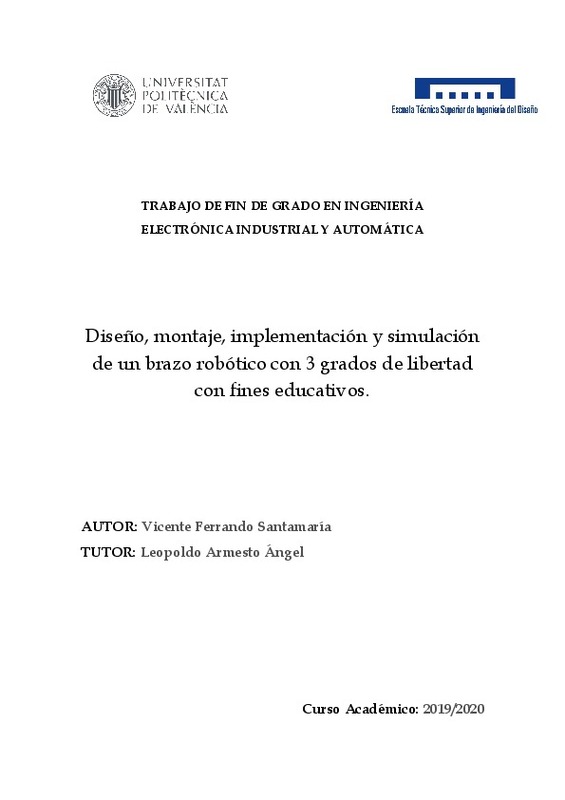JavaScript is disabled for your browser. Some features of this site may not work without it.
Buscar en RiuNet
Listar
Mi cuenta
Estadísticas
Ayuda RiuNet
Admin. UPV
Diseño, montaje, implementación y simulación de un brazo robótico con 3 grados de libertad con fines educativos
Mostrar el registro sencillo del ítem
Ficheros en el ítem
| dc.contributor.advisor | Armesto Ángel, Leopoldo
|
es_ES |
| dc.contributor.author | Ferrando Santamaría, Vicente
|
es_ES |
| dc.date.accessioned | 2020-10-27T14:37:23Z | |
| dc.date.available | 2020-10-27T14:37:23Z | |
| dc.date.created | 2020-09-28 | |
| dc.date.issued | 2020-10-27 | es_ES |
| dc.identifier.uri | http://hdl.handle.net/10251/153275 | |
| dc.description.abstract | [ES] El objetivo de este TFG es proporcionar a alumnos de cualquier titulación/asignatura relacionada con la robótica los planos, el diseño y el código de un brazo robótico con 3 grados de libertad para que puedan crear su propio robot a un precio económico. Para la realización del proyecto se deberá de resolver una serie de problemas. En primer lugar, se deben identificar los elementos con los que se compondrá el robot, tales como motores, fuente de alimentación, controlador de los motores Los elementos que se adquieran deberán ser lo más económicos posibles siempre y cuando cumplan con las especificaciones necesarias para mover el robot sin problema. Una vez se tengan identificados, se procederá al diseño del brazo robótico utilizando un programa de diseño y ensamblaje de piezas. No se buscará un diseño complejo, sino más bien simple para agilizar y simplificar el proceso de fabricación y ensamblaje de piezas por parte de los alumnos que monten el robot. Al finalizar el diseño, se importarán las piezas a un programa de simulación para comprobar el correcto funcionamiento dinámico del robot y se procederá a construir el robot. En cuanto al funcionamiento del robot, se programará para que funcione en cinemática inversa y tenga dos modos de actuación, el manual y el automático. En el manual moveremos el robot sobre los ejes x, y, z mediante sliders y en el modo automático crearemos una trayectoria que seguirá el robot. Una vez que los modos de funcionamiento se ejecuten correctamente en el simulador se procederá a transmitir las instrucciones por puerto serie a los motores. | es_ES |
| dc.description.abstract | [EN] The goalof this project is to provide students of any degree / subject related to robotics, design and coding of a robotic arm with 3 degrees of freedom so that they can create their own robot at an economical price. To carry out the project, a series of problems must be solved. First of all, the elements with which the robot will be composed must be identified, such as motors, power supply, motor controller. The elements purchased must be as economical as possible as long as they meet the necessary specifications for move the robot without problem. Once they are identified, the robotic arm will be designed using a parts design and assembly program. It will not seek a complex design, but rather a simple one to streamline and simplify the process of manufacturing and assembling parts by the students who assemble the robot. At the end of the design, the parts will be imported into a simulation program to check the correct dynamic operation of the robot and the robot will be built. Regarding the operation of the robot, it will be programmed to work in reverse kinematics and have two actuation modes, manual and automatic. In the manual we will move the robot on the x, y, and z axes using sliders and in automatic mode we will create a path that the robot will follow. Once the operating modes are correctly executed in the simulator, the instructions will be transmitted through the serial port to the motors. | es_ES |
| dc.format.extent | 127 | es_ES |
| dc.language | Español | es_ES |
| dc.publisher | Universitat Politècnica de València | es_ES |
| dc.rights | Reserva de todos los derechos | es_ES |
| dc.subject | Brazo | es_ES |
| dc.subject | Robótico | es_ES |
| dc.subject | Robótica | es_ES |
| dc.subject | Cinemática | es_ES |
| dc.subject | Inversa | es_ES |
| dc.subject | Arm | es_ES |
| dc.subject | Robotic robotics | es_ES |
| dc.subject | Kinematic | es_ES |
| dc.subject | Inverse | es_ES |
| dc.subject.classification | INGENIERIA DE SISTEMAS Y AUTOMATICA | es_ES |
| dc.subject.other | Grado en Ingeniería Electrónica Industrial y Automática-Grau en Enginyeria Electrònica Industrial i Automàtica | es_ES |
| dc.title | Diseño, montaje, implementación y simulación de un brazo robótico con 3 grados de libertad con fines educativos | es_ES |
| dc.type | Proyecto/Trabajo fin de carrera/grado | es_ES |
| dc.rights.accessRights | Abierto | es_ES |
| dc.contributor.affiliation | Universitat Politècnica de València. Departamento de Ingeniería de Sistemas y Automática - Departament d'Enginyeria de Sistemes i Automàtica | es_ES |
| dc.contributor.affiliation | Universitat Politècnica de València. Escuela Técnica Superior de Ingeniería del Diseño - Escola Tècnica Superior d'Enginyeria del Disseny | es_ES |
| dc.description.bibliographicCitation | Ferrando Santamaría, V. (2020). Diseño, montaje, implementación y simulación de un brazo robótico con 3 grados de libertad con fines educativos. Universitat Politècnica de València. http://hdl.handle.net/10251/153275 | es_ES |
| dc.description.accrualMethod | TFGM | es_ES |
| dc.relation.pasarela | TFGM\135007 | es_ES |
Este ítem aparece en la(s) siguiente(s) colección(ones)
-
ETSID - Trabajos académicos [8906]
Escuela Técnica Superior de Ingeniería del Diseño






